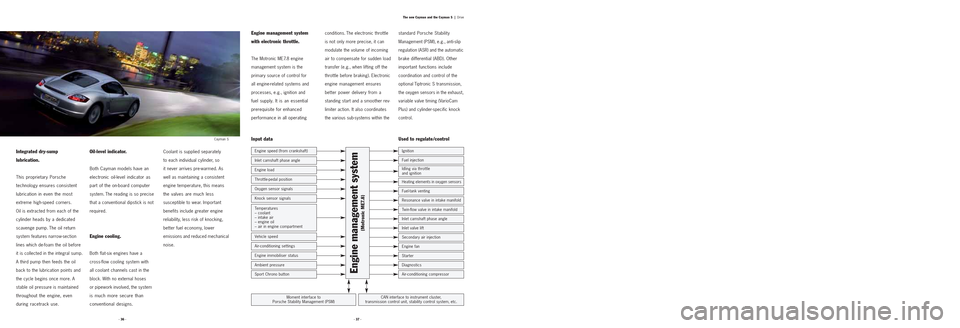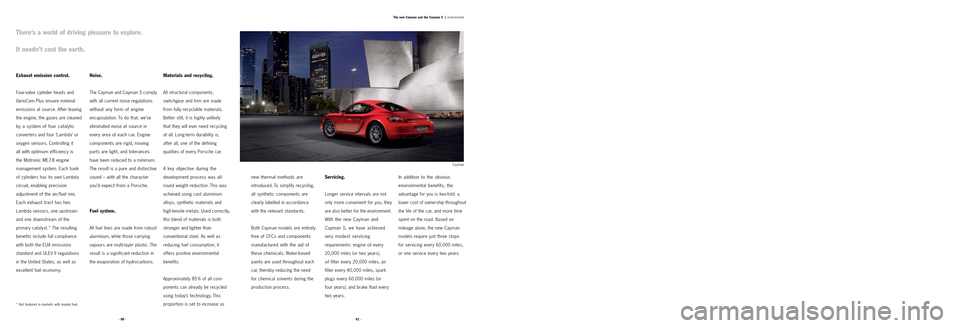brake sensor PORSCHE CAYMAN 2006 1.G Information Manual
[x] Cancel search | Manufacturer: PORSCHE, Model Year: 2006, Model line: CAYMAN, Model: PORSCHE CAYMAN 2006 1.GPages: 61, PDF Size: 2.24 MB
Page 17 of 61

· 37 · · 36 ·The new Cayman and the Cayman S |
Drive
Integrated dry-sump
lubrication.
This proprietary Porsche
technology ensures consistent
lubrication in even the most
extreme high-speed corners.
Oil is extracted from each of the
cylinder heads by a dedicated
scavenge pump. The oil return
system features narrow-section
lines which de-foam the oil before
it is collected in the integral sump.
A third pump then feeds the oil
back to the lubrication points and
the cycle begins once more. A
stable oil pressure is maintained
throughout the engine, even
during racetrack use.
Oil-level indicator.
Both Cayman models have an
electronic oil-level indicator as
part of the on-board computer
system. The reading is so precise
that a conventional dipstick is not
required.
Engine cooling.
Both flat-six engines have a
cross-flow cooling system with
all coolant channels cast in the
block. With no external hoses
or pipework involved, the system
is much more secure than
conventional designs.
Coolant is supplied separately
to each individual cylinder, so
it never arrives pre-warmed. As
well as maintaining a consistent
engine temperature, this means
the valves are much less
susceptible to wear. Important
benefits include greater engine
reliability, less risk of knocking,
better fuel economy, lower
emissions and reduced mechanical
noise.
Engine management system
with electronic throttle.
The Motronic ME7.8 engine
management system is the
primary source of control for
all engine-related systems and
processes, e.g., ignition and
fuel supply. It is an essential
prerequisite for enhanced
performance in all operating
conditions. The electronic throttle
is not only more precise, it can
modulate the volume of incoming
air to compensate for sudden load
transfer (e.g., when lifting off the
throttle before braking). Electronic
engine management ensures
better power delivery from a
standing start and a smoother rev-
limiter action. It also coordinates
the various sub-systems within the
Used to regulate /control
Engine management system
(Motronic ME7.8)
Engine load
Throttle-pedal position
Oxygen sensor signals
Engine speed (from crankshaft)
Inlet camshaft phase angle
Knock sensor signals
Vehicle speed
Air-conditioning settings
Engine immobiliser status
Ambient pressure
Sport Chrono button
Temperatures
– coolant
– intake air
– engine oil
– air in engine compartment
Ignition
Fuel injection
Idling via throttle
and ignition
Heating elements in oxygen sensors
Fuel-tank venting
CAN interface to instrument cluster,
transmission control unit, stability control system, etc.Moment interface to
Porsche Stability Management (PSM)
Input data
Twin-flow valve in intake manifold
Resonance valve in intake manifold
Inlet camshaft phase angle
Inlet valve lift
Secondary air injection
Engine fan
Starter
Diagnostics
Air-conditioning compressor
standard Porsche Stability
Management (PSM), e.g., anti-slip
regulation (ASR) and the automatic
brake differential (ABD). Other
important functions include
coordination and control of the
optional Tiptronic S transmission,
the oxygen sensors in the exhaust,
variable valve timing (VarioCam
Plus) and cylinder-specific knock
control.
Cayman S
Page 25 of 61

· 53 · · 52 ·The new Cayman and the Cayman S |
Chassis
Porsche Active Suspension
Management (PASM).
PASM is an electronic damping
control system. Available on
both Cayman models, it offers
continuous adjustment of
individual damping forces based
on current road conditions and
driving style. Agility and driving
pleasure are significantly
enhanced while retaining the
car’s natural ride quality. Equipped
with PASM, the car rides 10 mm
lower than with the standard
steel-sprung suspension.
The driver can choose one of
two setup modes, ‘Normal’ or
‘Sport’. While the first is a blend
of performance and comfort, the
‘Sport’ setup ratings are generally
much firmer, enabling greater
agility on the racetrack. In either
mode, the system responds to
changing loads by automatically
applying the optimum damping
rate on each individual wheel.
The rates are selected from a
range of map options which are
specially adapted to the unique
dynamics of the Cayman and
Cayman S.
The movement of the body is
continuously monitored under
acceleration, braking and cornering
manoeuvres, as well as on poor
road surfaces. Other sensors
provide additional information on
lateral acceleration, steering
angle, brake pressure and engine
torque. A dedicated control unitprovides real-time analysis and
damper adjustment as defined
for the respective setup mode
(‘Normal’ or ‘Sport’). The result:
greater stability and more
consistent occupant comfort.
If, when ‘Sport’ mode is selected,
the quality of road surface drops
below a certain threshold, the
system immediately switches
to
a softer rating and restores
the car’s traction and grip.
When the road surface improves,
PASM returns to the original,
harder ratings. The system
remains active in ‘Normal’ mode,
too, automatically switching to a
harder setup if the car is driven
more assertively. As the dampers
become stiffer, the car becomes
more stable and driver control is
improved.
Rebound in ‘Normal’ mode –
damper piston with bypass
valve openRebound in ‘Sport’ mode –
damper piston with bypass
valve closed
Compression in ‘Sport’ mode –
damper piston with bypass
valve closed Compression in ‘Normal’ mode –
damper piston with bypass
valve open
Page 31 of 61

· 64 ·The new Cayman and the Cayman S |
Safety
it can never suspend the laws of
physics, PSM does provide that
extra margin of safety whenever
you need it most. A key component
in PSM is a specially optimised
anti-lock braking system (ABS)
offering safer deceleration and
shorter braking distances. PSM
is also invaluable when applying
the throttle on low-grip surfaces.
Here, it uses the ABD (automatic
brake differential) and ASR
(anti-slip regulation) functions to
maintain traction and stability.
In order to retain the car’s natural
agility, PSM combines a high
trigger threshold with precision
input characteristics.
Porsche Stability
Management (PSM).
This automatic vehicle stability
control system is standard
equipment on both Cayman
models. Throughout each journey,
PSM uses a range of sensors to
monitor the direction, speed, yaw
velocity and lateral acceleration
of the car. Using this information,
it is possible to calculate the
actual direction of travel at any
given moment. If the car begins
to oversteer or understeer,
PSM applies selective braking on
individual wheels to restore
stability and optimum speed. WhileThe PSM threshold is raised
higher still when ‘Sport’ mode is
selected on the optional Sport
Chrono Package/Sport Chrono
Package Plus. The resulting
drive is much more involving,
particularly at speeds up to
around 70 km / h (44 mph). If
you’d rather enjoy the car
unassisted, the system can be set
to standby. When ‘Sport’ mode is
selected, PSM will only intervene
under heavy braking where both
front wheels are in danger of
locking. In ‘Normal’ mode, PSM
automatically becomes active
as soon as one of the front
wheels requires ABS assistance.The upper section of each door
features additional reinforcements
(3) which enhance the rigidity of
the car. This upper load path (4)
is used to channel energy into
the side of the car and thus
provide additional protection for
the passenger cell.
Passive safety.
Both Cayman models easily
comply with all statutory
requirements in respect of frontal,
side, diagonal, rear impact and
rollover protection.
The bodyshell structure contains
a highly resilient passenger
cell offering exceptional crash
protection. At the front of the
car, the cell is protected by a
patented system of longitudinal
and transverse members (1). In
the event of an accident, energy
is absorbed and distributed by
the front-end structure, thereby
minimising cell deformation.
Additional features include a
bulkhead cross-member (2) made
from super high-strength steel.
This element is designed to
absorb impact forces from the
longitudinal members and thus
protect both front footwells.
· 65 ·
Sheet steel
Tailored blanks
High-strength steel
Super high-strength steel
Aluminium
1
1
1
1
3
42
Cayman
Page 44 of 61

· 90 ·
Exhaust emission control.
Four-valve cylinder heads and
VarioCam Plus ensure minimal
emissions at source. After leaving
the engine, the gases are cleaned
by a system of four catalytic
converters and four ‘Lambda’ or
oxygen sensors. Controlling it
all with optimum efficiency is
the Motronic ME7.8 engine
management system. Each bank
of cylinders has its own Lambda
circuit, enabling precision
adjustment of the air/fuel mix.
Each exhaust tract has two
Lambda sensors, one upstream
and one downstream of the
primary catalyst.* The resulting
benefits include full compliance
with both the EU4 emissions
standard and ULEV II regulations
in the United States, as well as
excellent fuel economy.
Noise.
The Cayman and Cayman S comply
with all current noise regulations
without any form of engine
encapsulation. To do that, we’ve
eliminated noise at source in
every area of each car. Engine
components are rigid, moving
parts are light, and tolerances
have been reduced to a minimum.
The result is a pure and distinctive
sound – with all the character
you’d expect from a Porsche.
Fuel system.
All fuel lines are made from robust
aluminium, while those carrying
vapours are multi-layer plastic. The
result is a significant reduction in
the evaporation of hydrocarbons.
Materials and recycling.
All structural components,
switchgear and trim are made
from fully recyclable materials.
Better still, it is highly unlikely
that they will ever need recycling
at all. Long-term durability is,
after all, one of the defining
qualities of every Porsche car.
A key objective during the
development process was all-
round weight reduction. This was
achieved using cast aluminium
alloys, synthetic materials and
high-tensile metals. Used correctly,
this blend of materials is both
stronger and lighter than
conventional
steel. As well as
reducing fuel consumption, it
offers positive environmental
benefits.
Approximately 85 % of all com-
ponents can already be recycled
using today’s technology. This
proportion is set to increase as
* Not featured in markets with leaded fuel.The new Cayman and the Cayman S |
Environment
new thermal methods are
introduced. To simplify recycling,
all synthetic components are
clearly labelled in accordance
with the relevant standards.
Both Cayman models are entirely
free of CFCs and components
manufactured with the aid of
these chemicals. Water-based
paints are used throughout each
car, thereby reducing the need
for chemical solvents during the
production process.
Servicing.
Longer service intervals are not
only more convenient for you, they
are also better for the environment.
With the new Cayman and
Cayman S, we have achieved
very modest servicing
requirements: engine oil every
20,000 miles (or two years),
oil filter every 20,000 miles, air
filter every 40,000 miles, spark
plugs every 60,000 miles (or
four years), and brake fluid every
two years.
In addition to the obvious
environmental benefits, the
advantage for you is two-fold: a
lower cost of ownership throughout
the life of the car, and more time
spent on the road. Based on
mileage alone, the new Cayman
models require just three stops
for servicing every 60,000 miles,
or one service every two years.
· 91 ·
There’s a world of driving pleasure to explore.
It needn’t cost the earth.
Cayman